Roles of Different Agencies in Identifying Health and Disease Levels
23 Pages5466 Words90 Views
Added on 2023-01-16
About This Document
This report explains how different agencies like WHO, National Department of Health, and Local Authorities play a role in identifying levels of health and disease in communities. It discusses their responsibilities and the measures they take to promote a healthy community and provide healthcare services.
Roles of Different Agencies in Identifying Health and Disease Levels
Added on 2023-01-16
ShareRelated Documents
Public Health
Introduction
This report explains how the government and many agencies act to
find out the rate of health and diseases within the community and to
find ways to prevent diseases and promoting quality life. To achieve
an effective measure in this report based on UK'S public health, the
data and images, also accurately explanation of epidemiology and
cross-infection is developed and explained bellow. Furthermore, this
report also discusses the effects and causes of diseases and provide
knowledge and education to support the community in an
international, national and local level.
1.1 Explain the roles of different agencies in identifying levels of
health and disease in communities.
Some organisations provide services for health and social care in the
UK, also in other European countries and worldwide. Meanwhile,
organisations such as; (WHO), Public Health (PH) and Local Authority,
which provides health care services will be in the discussion.
*World Health Organization (WHO); although this organisation does
not support other organisations working within the community and
local healthcare in different countries. The (WHO), focuses in
underpin many healthcare sectors mainly in countries vulnerable to
epidemiology and where the mortality rate is high. When the is an
event that compromises health condition on a broad scale, such as
earthquake, virus’s epidemiology and other issues, the WHO can
intervene aiding communities, to control and radicalise the diseases.
They may do it by sending experts, medication and resources. Also,
by laboratory investigation, creating vaccination and the best
Introduction
This report explains how the government and many agencies act to
find out the rate of health and diseases within the community and to
find ways to prevent diseases and promoting quality life. To achieve
an effective measure in this report based on UK'S public health, the
data and images, also accurately explanation of epidemiology and
cross-infection is developed and explained bellow. Furthermore, this
report also discusses the effects and causes of diseases and provide
knowledge and education to support the community in an
international, national and local level.
1.1 Explain the roles of different agencies in identifying levels of
health and disease in communities.
Some organisations provide services for health and social care in the
UK, also in other European countries and worldwide. Meanwhile,
organisations such as; (WHO), Public Health (PH) and Local Authority,
which provides health care services will be in the discussion.
*World Health Organization (WHO); although this organisation does
not support other organisations working within the community and
local healthcare in different countries. The (WHO), focuses in
underpin many healthcare sectors mainly in countries vulnerable to
epidemiology and where the mortality rate is high. When the is an
event that compromises health condition on a broad scale, such as
earthquake, virus’s epidemiology and other issues, the WHO can
intervene aiding communities, to control and radicalise the diseases.
They may do it by sending experts, medication and resources. Also,
by laboratory investigation, creating vaccination and the best
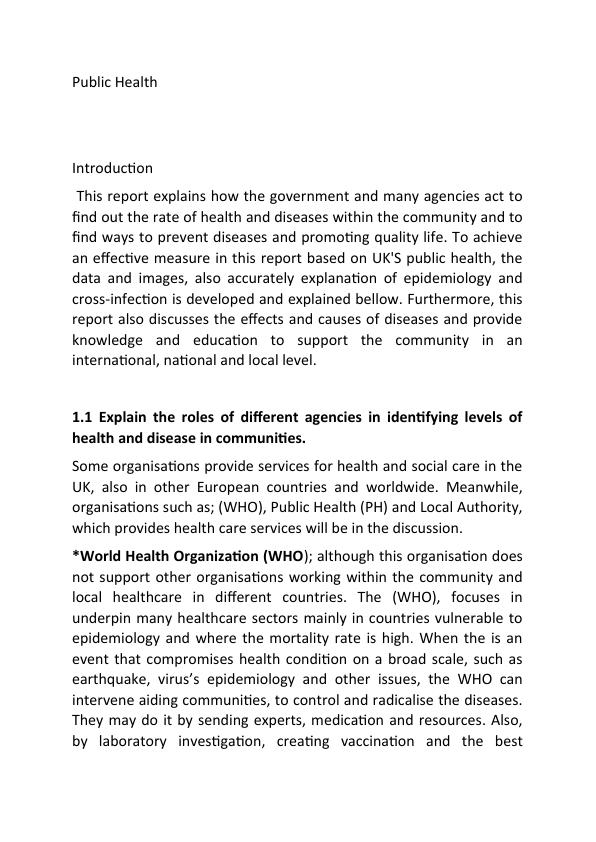
medication to tackle the health issue in these countries and the local
community.
*National Department of Health; The Department of Health (DH)
has the responsibilities to find ways to promote a healthy community
and to eliminate the inequality concerning health and wellbeing in
different groups of citizens. Doing this, they are promoting quality
lifestyles, implementation of legislation and regulation, agent
educators, awareness by signs or pamphlets etc. They also support
the NHS and local authorities with plans and resources to achieve
their aims and any emergency events.
Concerning to Public Health England (PHE), there is a system of
monitoring the quantity of a determined infection that arises in
healthcare within the community or national. This monitoring is
achievable trough regular surveillance programmes. Also, the PHE
provide education and advice to make the individuals aware of the
prevention and infection control, mostly in health and social care
setting.
*Local Authorities;
According to (Eugene M.) since 2012, the responsibilities of public
health was transferred from NHS to Local Authority.
The local authority plays the role of working together between NHS,
GP, Care Home, Agencies and more, to improve the health quality of
the community. To assist the local citizens with information and
motivation, reducing the unhealthy lifestyle such as drugs and
alcohol consumption. The local authorities also put into practice the
recommendations and policies created by the DH to benefit the local
community. The local authority supports local discussions, make the
budget of resources and how they should be used to the benefit of
public health.
community.
*National Department of Health; The Department of Health (DH)
has the responsibilities to find ways to promote a healthy community
and to eliminate the inequality concerning health and wellbeing in
different groups of citizens. Doing this, they are promoting quality
lifestyles, implementation of legislation and regulation, agent
educators, awareness by signs or pamphlets etc. They also support
the NHS and local authorities with plans and resources to achieve
their aims and any emergency events.
Concerning to Public Health England (PHE), there is a system of
monitoring the quantity of a determined infection that arises in
healthcare within the community or national. This monitoring is
achievable trough regular surveillance programmes. Also, the PHE
provide education and advice to make the individuals aware of the
prevention and infection control, mostly in health and social care
setting.
*Local Authorities;
According to (Eugene M.) since 2012, the responsibilities of public
health was transferred from NHS to Local Authority.
The local authority plays the role of working together between NHS,
GP, Care Home, Agencies and more, to improve the health quality of
the community. To assist the local citizens with information and
motivation, reducing the unhealthy lifestyle such as drugs and
alcohol consumption. The local authorities also put into practice the
recommendations and policies created by the DH to benefit the local
community. The local authority supports local discussions, make the
budget of resources and how they should be used to the benefit of
public health.
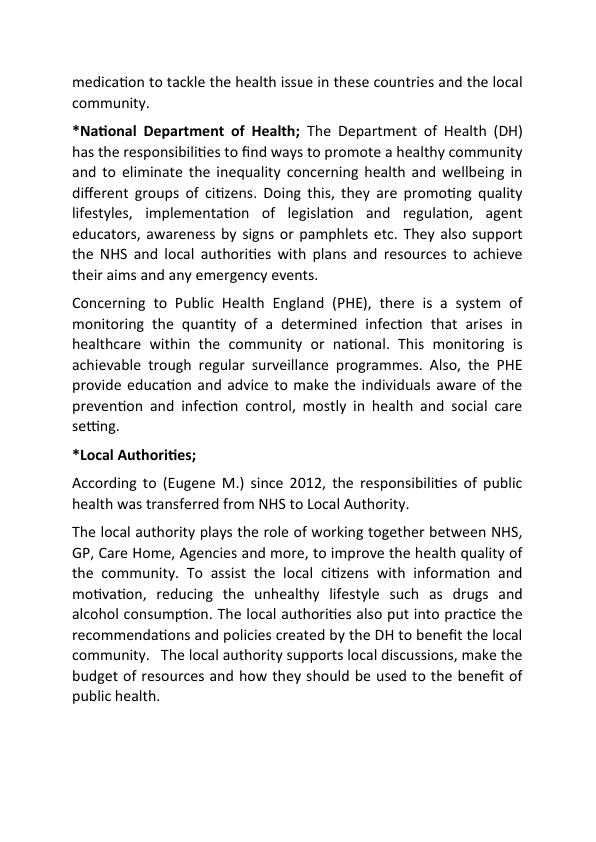
1.2 Explain, using statistical data, the epidemiology of one
infectious and one non-infectious disease that is widespread in
their own country.
*Epidemiology is the sum of the factors controlling the absence or
presence of a pathogen or disease. It also can be described as a
division of research in medical science dealings with distribution,
incidence, and control of the virus of diseases in a population.
* HIV
To HIV grow or reproduce, it attaches itself to the cells and
multiplicity then spread through the bloodstream. It infects T-
helper cells / DC4 cells, in another mean, the white blood cells.
It is essential that people infected with HIV are aware of it
sooner and seeks the treatment; antiretroviral is a medication
designed to reduce the effect of HIV and help the infected
people live longer (Avert.org 2019).
Public Health is making progress toward the goal of ending the
HIV/AIDS epidemic. Due to advancements in both the prevention and
treatment of HIV. However, significant challenges remain. Basic
principles of epidemic control are described in the context of HIV and
identify some achievable goals in regarding to the control and
elimination of HIV mainly in specific populations and risk groups,
given currently available HIV prevention and treatment methods
(
Jones J, Sullivan PS, and Curran JW 2019).
According to HIV and AIDS Reporting Section National Infection
Service Public Health England in September 2019; UNAIDS has set a
target of 90% of those diagnosed to be receiving treatment. Overall
in 2018, 97% of the 96,142 people living with a diagnosed HIV
infection in the UK received ART, compared to 82% in 2009 (
PHE.
2019).
infectious and one non-infectious disease that is widespread in
their own country.
*Epidemiology is the sum of the factors controlling the absence or
presence of a pathogen or disease. It also can be described as a
division of research in medical science dealings with distribution,
incidence, and control of the virus of diseases in a population.
* HIV
To HIV grow or reproduce, it attaches itself to the cells and
multiplicity then spread through the bloodstream. It infects T-
helper cells / DC4 cells, in another mean, the white blood cells.
It is essential that people infected with HIV are aware of it
sooner and seeks the treatment; antiretroviral is a medication
designed to reduce the effect of HIV and help the infected
people live longer (Avert.org 2019).
Public Health is making progress toward the goal of ending the
HIV/AIDS epidemic. Due to advancements in both the prevention and
treatment of HIV. However, significant challenges remain. Basic
principles of epidemic control are described in the context of HIV and
identify some achievable goals in regarding to the control and
elimination of HIV mainly in specific populations and risk groups,
given currently available HIV prevention and treatment methods
(
Jones J, Sullivan PS, and Curran JW 2019).
According to HIV and AIDS Reporting Section National Infection
Service Public Health England in September 2019; UNAIDS has set a
target of 90% of those diagnosed to be receiving treatment. Overall
in 2018, 97% of the 96,142 people living with a diagnosed HIV
infection in the UK received ART, compared to 82% in 2009 (
PHE.
2019).
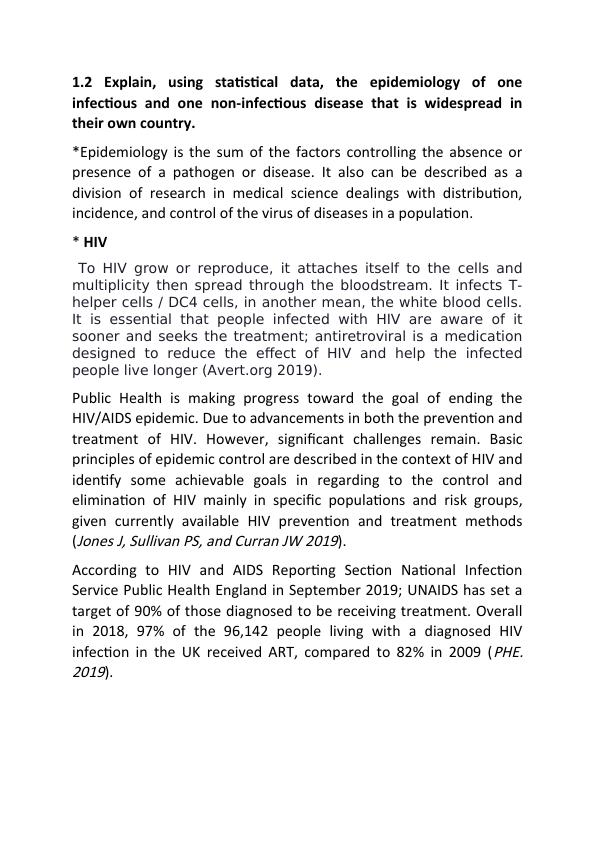
Public Health Statistic 2019
HIV statistic in United Kingdom 2019
*Diabetes Type 2.
Diabetes type 2 is one of the most long term health situations in
England.
HIV statistic in United Kingdom 2019
*Diabetes Type 2.
Diabetes type 2 is one of the most long term health situations in
England.
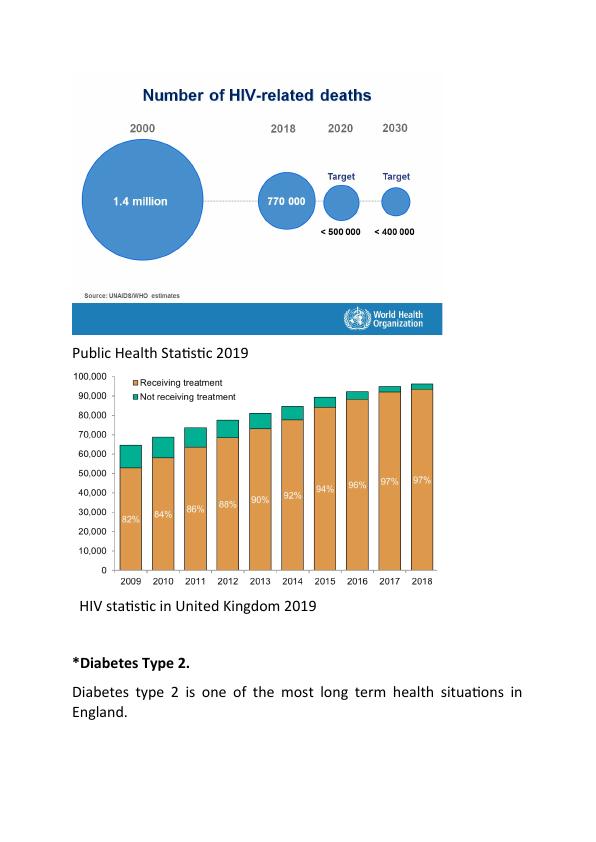
When the pancreas is not able to produce insulin to control blood
glucose level, people will develop Diabetes Type 2. In another way,
when the cell is not using the insulin created effectively. In that
circumstance, the glucose level becomes high, and the person is
diagnosed with hyperglycaemia. This type of diabetes is often
associated with obesity and elderly age people (
NHS Inform 2019).
The statistic shows that around 90% of people with diabetes have
type 2 diabetes, and it is more frequent in people of age 40 or more.
According to the (Diabetes.co.uk), about 415 million people in the
world have diabetes, an estimation of 1 in 11 adults in the wold. The
estimation also predicts that by 2040 642 million people will have
diabetes type 2 in the world.
Statistics show that 3.8 million people in the UK are diagnosed with
diabetes. Also, there is a prediction of 549.000 people with diabetes
but not diagnosed yet. Both diagnosed and not diagnosed summarise
an estimation of over 4.7 million people with diabetes in the UK, and
it mean that 6% of UK population have diabetes, and most of them
live in England. In term of type 2 diabetes 1 million people with it
does not know, because they was not diagnosed. 500 people are
dying weekly due to complication derivate from diabetes.
glucose level, people will develop Diabetes Type 2. In another way,
when the cell is not using the insulin created effectively. In that
circumstance, the glucose level becomes high, and the person is
diagnosed with hyperglycaemia. This type of diabetes is often
associated with obesity and elderly age people (
NHS Inform 2019).
The statistic shows that around 90% of people with diabetes have
type 2 diabetes, and it is more frequent in people of age 40 or more.
According to the (Diabetes.co.uk), about 415 million people in the
world have diabetes, an estimation of 1 in 11 adults in the wold. The
estimation also predicts that by 2040 642 million people will have
diabetes type 2 in the world.
Statistics show that 3.8 million people in the UK are diagnosed with
diabetes. Also, there is a prediction of 549.000 people with diabetes
but not diagnosed yet. Both diagnosed and not diagnosed summarise
an estimation of over 4.7 million people with diabetes in the UK, and
it mean that 6% of UK population have diabetes, and most of them
live in England. In term of type 2 diabetes 1 million people with it
does not know, because they was not diagnosed. 500 people are
dying weekly due to complication derivate from diabetes.
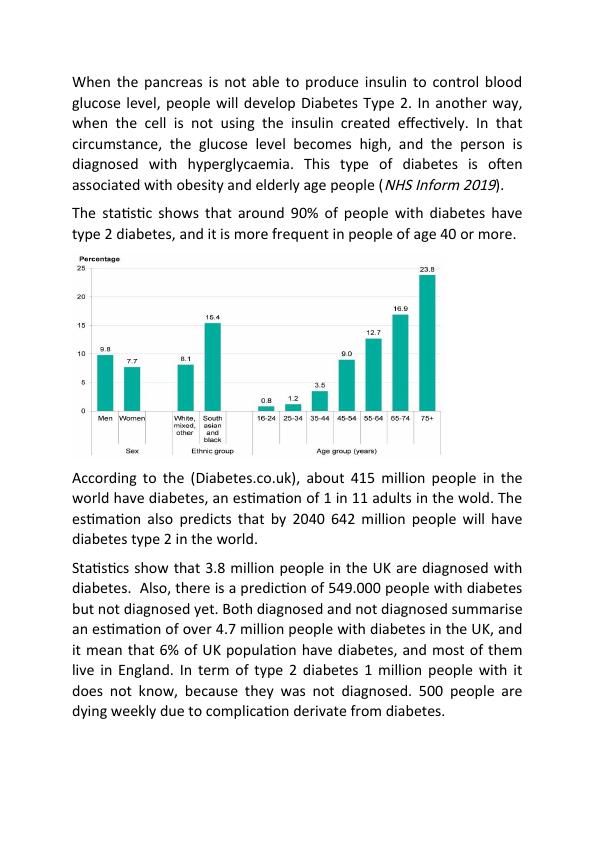
1.3 How effective are different approaches and strategies adopted
by NHS to control breast cancer and HIV in the UK.
Public health uses many strategies and approaches to measure and
control the incidences of diseases in the communities. Using these
by NHS to control breast cancer and HIV in the UK.
Public health uses many strategies and approaches to measure and
control the incidences of diseases in the communities. Using these
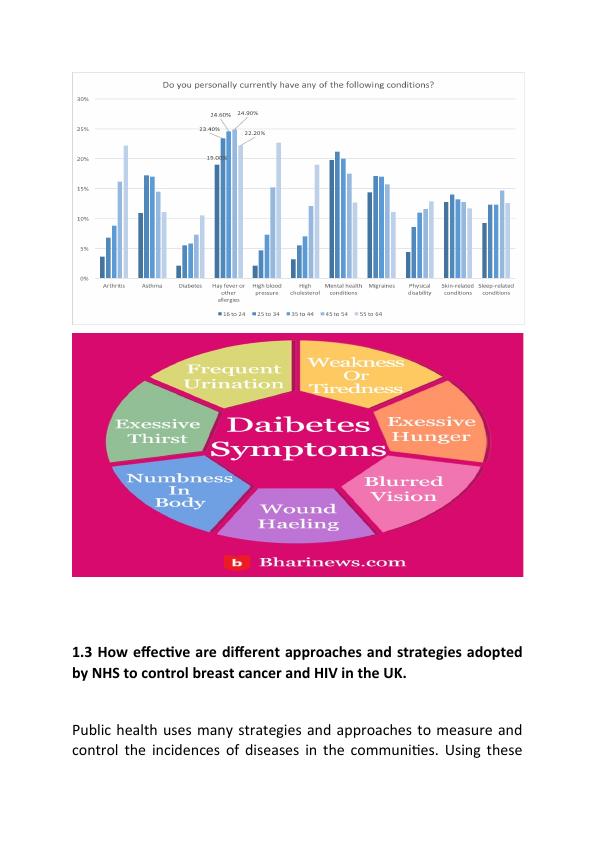
End of preview
Want to access all the pages? Upload your documents or become a member.
Related Documents
(solved) The Role of Public Health in Health & Social Carelg...
|12
|3094
|255
Unit 11 the role of public health in hsclg...
|8
|2495
|94
The Role Of Public Health In Health And Social Carelg...
|15
|5360
|25
Role of Public Health in Health and Social Care- Assignmentlg...
|13
|4442
|98
Approaches and Strategies to Control Diseases in Communitylg...
|24
|6817
|471
Public Health Role in Health & Social Carelg...
|13
|3910
|76
